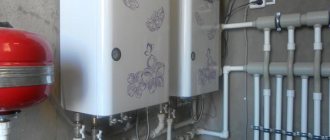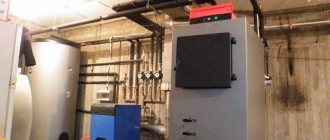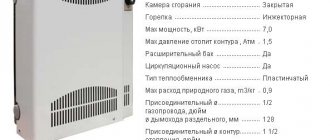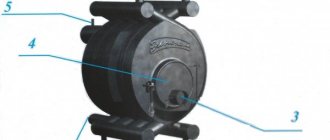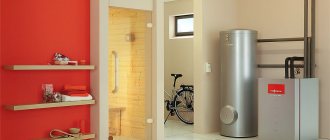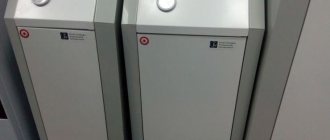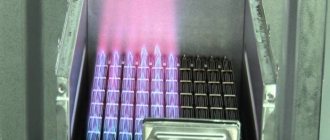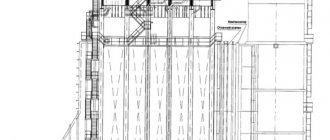Operating principle and advantages
A boiler that does not have a chimney completely or has one, but is very simple, has a number of its own unique design features and a certain operating principle, which we will discuss later.
Since gas is used to operate such a heating unit, the main requirement is the presence of a cylinder connected to the device or the presence of an already installed gas line. Also, although the name suggests that such a boiler is chimneyless, it still has a chimney, but in comparison with other large, complex and massive systems it is very simple.
In order to make such a hearth even more useful and powerful, to heat a large house with it, you can connect it to heating radiators and thereby convert it into systems with a water circuit. Heating in this case will be carried out by circulating and heating cold water in the radiators of each room. In the same way, you can get hot water in the house.
A double-circuit gas flueless boiler consists of the following elements:
- Gas lines or systems;
- A heat exchanger through which heated water moves and circulates;
- Return heating circuit;
- Through the input element, cold water enters the system;
- An output element that is used to remove and use already hot water for various domestic needs and purposes.
Such systems are complemented by two circuits at once, each of which is not connected to each other. This allows you to use them separately and for different needs. This variation can be supplemented with coolant, unlike single-circuit ones, which, at most, can be used to simultaneously heat and produce hot water using a device such as a boiler, which is purchased separately.
The most economical and budget-friendly variations are those that have a boiler with indirect heating, due to which closed local recirculation is formed. Thus, you can equip your home not just with hot water, but also get it heated to a certain temperature by simply opening the tap. The disadvantages include the bulkiness of such systems, due to which they will not fit into small houses and apartments. At the same time, the price of products manufactured by well-known and trusted brands is not always the lowest and most affordable.
Before you buy a chimneyless boiler, we recommend that you familiarize yourself in more detail with all its positive qualities and operational capabilities:
- Double-circuit variations of the modern model are distinguished by their average, and in some cases, quite miniature overall dimensions. Due to this, such a unit easily fits even in the smallest and most standard kitchen or in a specially designated utility room;
- The functionality of such centers is very large and varied. This is not just a heating device, but also the ability to connect to a water jacket to heat a large area. If you have a boiler, you can get water for domestic purposes;
- They are economical. The owner of the house can use such boiler equipment himself, as needed, thereby reducing resource consumption;
- Since double-circuit variations have a simple list of components, unlike single-circuit boiler systems, installation can be done with your own hands and without the help of a specialist.
The disadvantages of this variation are that it is not capable of performing several actions at the same time. For example, when performing the heating function, you will not be able to receive hot water. Also, water heating does not occur immediately, but gradually. Moreover, the smaller the size of the tank for filling and storing water, the less you will be able to provide your home or apartment with hot water
When using such a boiler, it is important to remember that, for example, when using water in the kitchen, it may not be enough for someone who is currently washing in the bathroom
Tips for choosing
When choosing a turbocharged boiler for installation in a house or apartment, you should pay attention to the following factors:
- Device design. For a separate boiler room in a private house, floor-standing models are more suitable; for an apartment, more compact wall-mounted ones are more suitable.
- Boiler functionality. If you need both heating and hot water supply, choose a dual-circuit model. If you get hot water from other sources, then you should not overpay - it is better to purchase a more affordable single-circuit option.
- Heat exchanger material. The higher its thermal conductivity, the better. So the best choice is a model with copper heat exchange devices, which ensure that heat loss is kept to a minimum.
- Automation system. Here you need to choose based on your wishes. For some, a model with simple adjustments and a minimum number of settings will be suitable, while for others, a boiler with intelligent control and the ability to program operation will be suitable.
- Power. Probably the most important parameter is that the correct selection of power determines how efficiently the boiler will heat the room. For typical houses and apartments with ceilings no higher than 3 m, it is advisable to choose heating devices at a rate of at least 1 - 1.2 kW per 10 m2 of area.
In addition, when installing a wall-mounted boiler, the coaxial chimney will take up more space, and its installation will be less labor intensive.
Don’t let this fairly extensive list scare you – in practice everything turns out to be much simpler. To select a turbocharged boiler with the optimal configuration, just contact specialists by calling 8 (495) 109-00-95. Our employees will provide you with all the necessary information, help you place your order, and, if necessary, organize the delivery/installation of the boiler to the specified premises.
Manufacturers and brands
Equipment of this class is produced by all well-known European companies, as well as domestic enterprises. If we consider its cost in relation to wall and floor options, then it is distributed in the same way as for boilers with an open combustion chamber. Wall-mounted options are cheaper, while floor-mounted ones have the highest price.
If we compare between local and foreign models, then here too there is no particular difference between boilers with an open and closed combustion chamber. Imported samples still have the highest prices, and products from domestic manufacturers are almost 50% cheaper.
If we consider boiler models from one manufacturer, for example, the very popular Italian company Baxi. Then its gas flueless floor-standing units have a price of around 2000, and wall-mounted models - about 1000 euros. The cost of wall-mounted boilers with an open combustion chamber under the brand name of this company is about 700-800 euros.
But, despite the higher price, chimneyless boilers are in great demand, especially when equipping apartment heating systems in multi-storey buildings.
Chimneys and material options for their installation
Current heating equipment powered by gas is characterized by a fairly high efficiency index and low temperatures of combustion products, which implies increased requirements for the materials from which chimneys are constructed. In the construction market, there is a gradual replacement of brick, steel, asbestos pipes, and galvanization with more modern ones. Increasingly, special protective sleeves are used, as well as stainless steel and Hungarian furanflex. Let's take a closer look at the parameters of each of these materials.
Galvanized pipes
Steel pipes are quickly exposed to corrosion, which makes the operation of a galvanized chimney quite short (about 3 years). The use of a specially designed protective coating can extend the service life up to 5 years.
Asbestos cement pipes
This material was widely used in organizing the removal of combustion products, despite the maximum temperature of 300 degrees Celsius. This option has an acceptable cost, but has a number of nuances that would have to be dealt with (for example, installing a chimney on a gas boiler is quite difficult in the vertical plane, insufficient tightness of the joints, the likelihood of rupture or splitting of pipes when they overheat, as well as the ability of asbestos cement to absorb moisture and condensate).
Brick chimney
Brick is far from the best material for creating a chimney, since condensation quickly destroys the integrity of this material. Quite often, in houses equipped with a brick chimney, the ceilings and walls are “decorated” with damp spots, which are formed due to the absorption of moisture and condensation by the brick.
Protective sleeve
The smoke exhaust device, which has equal perimeters of the ventilation duct and the protective sleeve, is a composite multilayer shell. The main function of this design is to protect smoke channels from the adverse effects of thermal gas flows. Special hoses can be used to seal ventilation channels; their use can minimize the effect of combustion products on the chimney, as well as improve draft and increase the operating time of the entire structure.
Furanflex
It is a new option that is used for chimney installations. It is made from reinforced plastic reinforced with special fibers. A distinctive feature of this material is its resistance to interaction with the acidic environment of condensate, low thermal conductivity and efficiency when operating at temperatures less than 200 degrees Celsius.
Stainless steel
This material is characterized by high levels of tightness and fire safety, quickly overcoming the threshold of condensation. Thanks to its round cross-section and smooth surface, stainless steel promotes maximum traction
When purchasing pipes of this type, you should pay attention to their marking data, since they can significantly affect the quality of welded joints, as well as options for connecting disparate elements into a single structure
What materials should exhaust pipes be made of?
Let's look at the options offered on the market, and also analyze the advantages and disadvantages of each.
Brick
This is a traditional chimney for a solid fuel boiler, a classic option that has been popular for ten years. Is it still relevant today, when there are several alternatives? The advantage of brick is that it can withstand temperatures up to 900°C. True, it slowly accumulates and releases heat and therefore is not entirely convenient in situations where you need to quickly warm up the premises of the house.
But there is also a minus, and a serious one, and it lies in the rapid destruction of the channel. Any, even the most accurate masonry turns out to be heterogeneous, as a result of which, over time, cracks and gaps appear between individual bricks, in which soot accumulates, steam is retained, and moisture collects. And a material such as fireclay does not withstand exposure to aggressive environments: the acids contained in the condensate corrode it within a few years.
Also, among the disadvantages can be noted:
- The high cost of materials and the laying work itself. At the same time, there are very few craftsmen who know how to lay out a chimney correctly.
- It is mandatory to have a foundation for such a chimney and to include it in the project in advance, before the start of construction.
Ceramic
They are three-layer structures, with an internal contour, internal thermal insulation and an external frame. They have a smooth surface that minimizes the accumulation of soot and does not absorb condensation. They are characterized by high tightness. With good care, they last up to 30 years, but at the same time they cost significantly more than steel ones, and the correct installation of a ceramic chimney for a solid fuel boiler in this case is possible with specialized skills. This is not the most budget-friendly choice. In this case, the installation must be planned at the stage of designing the house, since there is no possibility of installation in a finished building. Also, a foundation will be required due to the overall weight of the structure and the fixing mortar. A beginner obviously cannot cope with such a complex job, so it’s worth entrusting the job to the experts. But keep in mind that the installation speed of this chimney is lower than that of stainless steel ones, and replacing failed elements is always very difficult.
Glass
A fashionable novelty that has already achieved success in Europe. The main advantage is the original and spectacular appearance. And this is with good heat resistance and corrosion resistance.
- price: of all the options considered, they are the most expensive;
- lack of experience of widespread use in Russia.
Parapet heating systems
One of the types of gas chimney boilers is parapet. The design resembles the design of condensing equipment. The main difference from the latter is the presence of a closed combustion chamber. During operation, air, which is inevitably consumed during combustion, enters the firebox not from the room itself, but from the street, therefore, overheating does not occur and the oxygen concentration does not decrease. As a result of this method of operation, the efficiency, environmental friendliness and efficiency of equipment increase
It is important to remember that some types of equipment, in addition to the traditional heat exchanger, have a convection casing in their design, which allows you to heat the room, consuming less gas, that is, with greater efficiency. There are mounted types of parapet equipment, which are mostly energy-dependent and also require additional power from electrical networks
At the same time, floor-standing units are completely energy independent.
What is a coaxial chimney
A coaxial chimney is two plastic pipes, one in one. Combustion products are removed through the inner pipe, and air from the street is taken in through the layer between the pipes.
This design allows you to cool combustion products and make a chimney from plastic pipes. Cooling occurs with air coming from the street.
How to make a chimney for a flueless boiler
The advantages and disadvantages of chimneyless boilers have been discussed more than once in various construction forums. In Europe, the units enjoy a well-deserved reputation as economical and reliable equipment with low installation requirements. Under domestic operating conditions, boilers' efficiency and productivity are somewhat reduced.
Several aspects can be highlighted as advantages:
- There is no need to coordinate with the gas service when installing a turbo boiler, provided that licensed and certified equipment is purchased.
- It is allowed to install the boiler in rooms with limited space, in apartment buildings and private houses. There is no need for forced ventilation of the room.
- Performance – chimneyless units use the temperature of heated flue gases to generate additional thermal energy, which increases the efficiency and efficiency of the devices.
What malfunctions often occur with chimneyless boilers?
Most malfunctions occur due to improper operation or installation of equipment. The specialist will try to find out the reasons why the chimneyless boiler goes out and eliminate them. There are several factors leading to this:
- Poor traction - non-compliance with the requirements for installing a coaxial pipe: exceeding the permissible vertical and horizontal sections leads to shutdown of the equipment.
- Voltage failures - in most cases, sensitive automation is installed in chimneyless units. If there is a voltage failure, the processor gives a signal to shut down.
- Malfunctions in the operation of automation - the design provides a large number of monitoring sensors: draft, heating of hot water and coolant, etc. Failure of any sensor leads to a shutdown.
If you follow the rules for installing chimneyless wall-mounted heating boilers and carry out regular maintenance, the devices will operate without complaints or difficulties throughout their entire service life.
How to deal with blowing out of a chimneyless turbo boiler?
One of the main problems that owners of chimneyless heating equipment face is shutdown due to poor draft or blowing out of the boiler. The danger of chimney backdraft for a boiler with a closed combustion chamber lies in the likelihood of carbon dioxide entering the room, as well as failure of individual components.
There are several ways to troubleshoot the problem:
- Improve the draft in the boiler by installing a deflector that increases the draft by approximately 1.5 times.
- Install wind protection - a block mounted on the head of the pipe reliably protects against wind.
- If the situation is not corrected, the coaxial chimney is redone, taking into account the technical requirements for the location of the chimney, when installing a turbocharged boiler with a closed combustion chamber in a private house.
In Europe, it is mandatory to install a gas detector when operating any gas equipment. In our country, this is a desirable measure that has already saved dozens of lives.
Which boiler is better - chimney or flueless, expert opinion
When answering this question, it should be taken into account that condensing / chimneyless boilers were created for operating conditions in low-temperature coolant heating mode. The 95% efficiency declared by the manufacturer is only possible if the return temperature is no more than 40°C. In the harsh Russian winter, it is quite difficult to fulfill this condition.
Installing a boiler with a closed combustion chamber in a regular chimney when replacing old equipment with new equipment is prohibited. You will have to redo the smoke exhaust system, which is quite expensive. Chimneyless units are optimally suited for well-insulated buildings located in temperate climates.
Lemax Patriot - flueless, non-volatile boilers with a closed combustion chamber
Lemax steel gas boilers of the Patriot series, equipped with a hermetically sealed combustion chamber, are designed for organizing individual heating systems in apartment buildings and private households. A non-volatile parapet boiler can be operated in a heating system with natural or forced circulation without the need to connect to the electrical network. The boilers have a unique patented design.
Quick installation and convenient operation
A universal heating unit of a chimneyless design is designed for installation near the outer wall of a building made of non-combustible materials. Special holes in the lower part of the front panel of the boiler provide a convection effect. Air intake for complete combustion of fuel is carried out outside the room.
Advantages of parapet boilers of the “Patriot” series from:
- The power range includes heating units from 6 kW to 20 kW;
- Compact overall dimensions;
- Easy installation;
- Non-volatile design;
- Efficiency not lower than 87%;
- Practical and safe smoke removal system;
- Convenient combustion control of the ignition and main burner through the viewing window;
- Sealed combustion chamber, eliminating the risk of carbon monoxide entering the heated room;
- Effective system of protection against overheating of the unit;
A wide range of capacities allows you to select the optimal boiler model that matches the overall dimensions of the room and the planned temperature parameters.
Durability and safety
Removable elements of protective and decorative cladding and profile equipment provide convenient maintenance of boiler equipment. High-quality anti-corrosion enamel, resistant to high temperatures, in combination with treatment with an inhibitory compound guarantees effective protection of the steel heat exchanger from the influence of:
- Mineral oils;
- Salt solutions;
- Various aggressive factors.
The durability of Patriot boilers is based on the use of a gas burner device and a reliable gas valve from the Italian company, as well as on the use of a POLIDORO micro-flare injection burner. At the customer's request, the coaxial smoke exhaust system can be made of corrosion-resistant stainless steel.
Highly efficient gas boilers of the Lemax brand of the Patriot line are designed for installation in administrative buildings, apartments, and private houses without connecting to the electrical network. Heating devices work with natural and forced heating systems. By venting the exhaust pipe outside the room, air is taken in for the combustion process without a chimney. The high-strength steel heat exchanger is covered with composite materials that protect the unit from aggressive factors. The entire line of Patriot boilers is equipped with a safety system, including multi-level protection against overheating. Model line power: 6-20 kW. For the production of boilers, Italian automatic equipment and an original Polidoro burner are used.
Lemax Patriot-6
The Patriot-6 gas boiler of the Lemax brand is an excellent purchase for efficient heating of premises and various structures. The equipment can become either an individual heat source or a backup one. The heating capacity of the device is 6 kW. The heating device combines the latest technology, reliability, and proven quality.
Lemax Patriot-7.5
The Patriot-7.5 gas boiler of the Lemax brand with a closed combustion chamber has a maximum power of 9 kW. The equipment operates without an additional chimney, which has a positive effect on the favorable climate in the apartment. A special feature of the model is a steel heat exchanger coated with a special anti-corrosion enamel.
Lemax Patriot-10
The gas boiler "Patriot-10" of the Lemax brand is not connected to the electrical network. The devices have a unique design of the smoke removal system, which ensures a comfortable stay in a heated room. They work in natural and forced heating systems. Thermal power of the boiler is 12 kW.
Lemax Patriot-12.5
The gas boiler "Patriot-12.5" of the Lemax brand is reliable professional equipment that is installed in administrative buildings and residential buildings. A 15 kW heating device efficiently heats the room. At the same time, gas is consumed economically: 0.75 m3/h.
Lemax Patriot-16
The Patriot-16 gas boiler of the Lemax brand with a rated power of 19 kW is professional heating equipment that is installed in residential buildings and administrative buildings. The device is not connected to the mains and has a unique multi-level security system.
Lemax Patriot-20
The Patriot-20 gas boiler of the Lemax brand is a reliable heating device with a power of 24 kW. The device is made of modern anti-corrosion materials. The equipment is distinguished by unique Italian automation and a high-quality burner of the Polidoro system.
Features of the design, operation and installation of floor-standing chimneyless gas boilers
If it is impossible to install a classic vertical chimney, flueless gas boilers are used for heating. For such heating equipment, a separate ventilated room for natural draft is not equipped.
Despite the name “flueless”, such boilers do have a chimney. Its role is played by a compact coaxial pipe, which provides draft and removal of smoke masses from the combustion chamber.
External outlet of coaxial chimney
Design and principle of operation of chimneyless boiler equipment.
Chimneyless boilers, like classic gas boilers, operate in heating mode - single-circuit, and also as water heaters (DHW) - double-circuit.
A distinctive feature of the design is a closed combustion chamber. The burner, through which the gas heats the water in the system, is located in a sealed chamber. Thus, carbon monoxide, soot and smoke from fuel combustion do not penetrate into the room, and the boiler’s operating efficiency increases.
Oxygen-saturated combustion air enters the closed chamber through the external chimney block. The air heated by the burner element heats the copper circuit through which the coolant flows. Then the “exhaust” air, together with the products of fuel combustion, exits through the internal block of the coaxial pipe.
Scheme of operation of a floor-standing coaxial boiler
The coaxial chimney is simple to implement. These are two coaxial pipes of different diameters, fastened together. In this way, the heated gas waste is cooled by the air entering the chamber, making the boiler fireproof and environmentally friendly for the residents of the house. By cooling the combustion products, the air enters the combustion chamber already heated, which saves energy resources.
To prevent insufficient draft, high-power gas boilers are equipped with deflectors that increase the air flow by one and a half times. If there is a possibility of wind blowing, a special wind protection block is installed at the pipe outlet.
Features of installation of gas boilers with a coaxial chimney.
Floor-standing chimneyless boilers for autonomous heating systems are installed in small buildings and in multi-apartment buildings or industrial premises.
Chimneyless gas boilers are installed on a special stand. If the boiler is controlled by an electronic board, it is connected to electricity according to the rules for installing electric and gas equipment by specialists.
They are included in the heating system and gas mains in the same way as chimney gas boilers. The difference is the installation of a coaxial chimney.
Installation diagram of a horizontal coaxial chimney
Requirements for installing a coaxial pipe as a chimney:
- The chimney outlet to the street runs horizontally through the wall. The length of this pipe section is no more than 1 meter.
- The chimney is horizontal, but if horizontal exhaust is not possible, a vertical chimney is used. The length of the vertical part of such a chimney is about 3 meters.
- The outer part of the pipe is located no lower than 2 meters from the ground.
- The distance from the pipe to window or door openings is at least half a meter.
- Do not place the pipe outlet under a window.
- To prevent the accumulation of condensation liquid, it is installed at an angle of 3-5 degrees.
- Observe the diameters of the coaxial chimney pipes and their ratio for fire safety.
- The hole drilled in the wall for the pipe is lined with insulation made of non-flammable material.
Compliance with these requirements will ensure the boiler operates safely and efficiently.
Chimneyless boilers - their pros and cons of operation.
The advantage of floor heaters equipped with a coaxial pipe is installation in a living room. To fit the boilers into the interior, the finishing of the walls and the junction of the chimney with the wall is selected.
More details about coaxial chimneys and their use for gas boilers can be found in the video below.
Coaxial boiler in the interior of the apartment
Besides this, other advantages:
- simplicity and low cost of installation;
- there is no need to install supply and exhaust ventilation;
- high power of units of such a design that they heat large areas;
- some gas models are equipped with convection holes, which makes it possible to heat a room without a radiator;
- long service life.
The disadvantages of coaxial boilers are the smoke exhaust system. The length of the smoke exhaust pipe is no more than 5 meters. During frosts, chimneyless boilers operate at high power, which causes more condensation to form in the coaxial pipe, which freezes and blocks the air supply and smoke removal. Blowing out of the chimney occurs if it is not equipped with a wind protection.
The main advantages of turbocharged boilers
Turbocharged boilers, which do not require a stationary chimney, have a number of advantages:
- The device can be installed almost anywhere, and not just where the chimney was built into the structure of the room. The coaxial pipe, which provides air intake and exhaust of combustion products, is compact in size and can be installed with relatively little labor.
- Fuel combustion occurs in a sealed chamber, which has no contact with the atmosphere of the room. Therefore, neither “burning” oxygen in the house, nor, especially, carbon monoxide poisoning will definitely threaten you!
- High energy efficiency. The presence of a turbine allows for complete combustion of fuel and activates heat exchange. Efficiency is also increased through the use of modern boiler operation control systems, which automatically regulate the intensity of its operation depending on the specified settings.
If we talk about the shortcomings of the devices, the first thing that comes to mind is the higher price (compared to standard boilers that require connection to a stationary chimney). But saving resources due to more efficient fuel combustion, increased safety, as well as the ability to install almost anywhere allows you to put up with this disadvantage.
What we pay attention to
Heating devices with a closed combustion chamber include a coaxial chimney for a gas boiler.
It is designed to ensure smooth operation of the device. And serious requirements are placed on it, because combustion products are released through it, which are very harmful to human health. Therefore, it is recommended to install it through a wall in which there are no window or ventilation openings.
In all other parameters, the criteria for choosing a gas flueless boiler do not differ from others
When purchasing it, you should also pay attention to:
- power
- compactness
- design
- ignition options
The brand of the manufacturer is also an important factor, and since each of them has a wide range of products, it is worth evaluating several different samples to decide which one is best suited for the room.
Flueless boilers are divided into:
Let's start our consideration with floor-standing boilers from the Slovak manufacturer Proterm. They are non-volatile and have an efficiency of 90%, are reliably protected from overheating and are supplied assembled. Floor-standing boilers have high power ratings and can be used for heating large rooms, and also have other remarkable characteristics:
- reliability
- ease of use
- relatively low price
- possibility of changing fuel
The next noteworthy models are gas boilers with a coaxial chimney from a Korean manufacturer; today they are leaders in the sales market and not only because they have a low cost, but also due to a fairly large list of high performance indicators.
When choosing these devices, even the brand is not so important. It can be:
All of them are well adapted for use in the Russian climate and have high quality indicators, a large number of safety sensors and are very easy to operate.
German chimneyless boilers are undeniable in their reliability and quality. Not only are they designed for a long service life, but they also have a lot of advantages, not the least of which is environmental friendliness.
The brand plays a significant role when choosing, but you should not lose sight of other parameters:
They are also important and must be taken into account when purchasing.
SNiP standards
The manufacture and installation of any chimney structures must comply with all requirements of SNiP 2.04.05-91 and DBN V.2.5-20-2001. Such adherence to standards guarantees the safe operation of the heating system. Violation of the conditions listed in the documents can lead to problematic situations, the solution of which will require the participation of the gas industry.
Abstracts from the main regulatory documents:
- The structure of the condensate collector should solve the problem of moisture accumulation on the walls of the chimney;
- Good traction is a must;
- The head of the chimney must be free and do not allow the presence of deflectors or fungi on it that inhibit the removal of combustion products;
- A careful fit of all structural elements at their connection points is mandatory;
- Tight sealing at joints and all kinds of connections is required.
Chimney boilers general information
When choosing chimney boilers powered by natural gas, you need to know what types of this equipment are on sale today. Popular types are:
- Parapet boilers;
- Mounted;
- Floor-standing.
When choosing heating equipment, you should pay special attention to the following indicators and parameters:
- Possibility of additional power supply from electricity in case of emergency shutdown;
- The presence or absence of a circuit and/or built-in boiler;
- Performance.
Despite the fact that the equipment produced in our country does not have a wide range of capabilities and the functionality is much more modest than that of analogues from Western countries and Japan, the reliability and durability of all elements allow it to be used for heating rooms of various sizes without loss in performance
It is important that all gas boilers are completely safe, since they undergo preliminary quality control before entering the market
